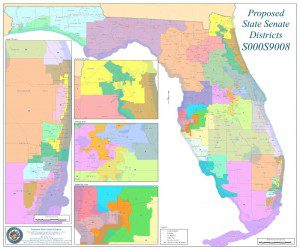Shortly after the curtain came down on the 2012 regular legislative session, lawmakers were already considering the contours of the redistricting session that will begin Wednesday.
And they already have some ideas about the scope of the changes to the Senate plan, the only one struck down by the Florida Supreme Court, and the role of the House in recasting the lines to the court’s liking. Both will be limited.
Shortly after the court announced a 5-2 ruling Friday that the Senate clearly did not comply with the anti-gerrymanding Fair Districts amendments approved by voters, Senate leaders made it clear that they would hold the House to a “gentlemen’s agreement” that each chamber got to draw its own lines.
In the earliest hours of Saturday morning, following a brief post-midnight celebration of the end of the session, House Redistricting Chairman Will Weatherford, R-Wesley Chapel, suggested that he was content to play second fiddle.
“I think the House is always going to show deference to the Senate when it comes to the Senate maps,” Weatherford said. “But at the same time, we certainly have opinions. We’re going to work with them and assist them in hopefully drawing a very legally compliant map.”
As for the map itself — Senate leaders cautioned against expecting sweeping changes to the map. They instead cast the Supreme Court decision as an endorsement of the overwhelming majority of districts — only eight of the 40 districts and the numbering system for seats were specifically thrown out — and said that only tweaks were needed.
“Given the fact that 80 percent of our seats were ratified, I’m sure the last 20 percent will come in line with their recommendations,” said Senate President Mike Haridopolos, R-Merritt Island.
And while any change to the unconstitutional districts will inevitably ripple across other parts of the map, and the court tossed districts in practically every major region of the state, Senate leaders said the damage was limited.
“We’re not starting with a clean sheet of paper, as some of our critics wanted us to,” said Senate Reapportionment Chairman Don Gaetz, R-Niceville. “We’re starting I think with a roadmap that will help us get where we need to go.”
Those steps are in some cases clearly spelled out: For example, the court tossed the districts of Gaetz and Sen. Greg Evers, R-Baker, because it said lawmakers could not justify dividing the Panhandle into two districts that ran east-to-west, dividing a number of counties, instead of a north-south alignment.
But other cases are more ambiguous. The court encouraged the Legislature to consider whether it could unite Lakeland into one district under the map, but did not order lawmakers to change the plan’s decision to split the city into two.
There isn’t much time to fix the problems — lawmakers will have two weeks once the session starts — and the next map will be the Legislature’s last shot at drawing Senate lines. Under the constitution, a new set of lines would be crafted by the court if the second draft fails, though the court stressed Friday that it didn’t want to take that step.
“As the next phase of this apportionment process begins, we are confident the Legislature will apply these standards in a manner consistent with the interpretation we have heretofore provided, keeping as its goal a Senate plan that would pass constitutional muster,” Justice Barbara Pariente wrote for the majority. “The Court views its constitutional obligation of drawing a plan to be the course of last resort.”
Haridopolos said he’s confident the chamber can meet the deadline, but he was more hesitant on predicting whether the maps would be approved. Lawmakers lost a 2010 battle at the Supreme Court over a separate redistricting amendment that Haridopolos spearheaded, and have suffered other legal setbacks to their agenda in recent months.
“I can never predict the Supreme Court,” he said wryly, while noting he called Friday’s decision, “That’s official.”
By Brandon Larrabee



